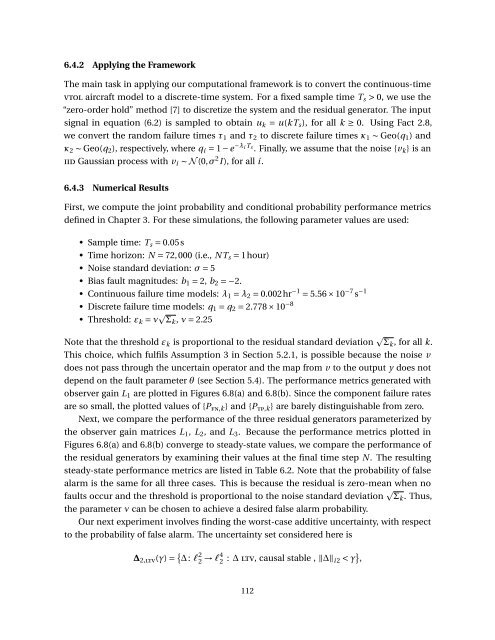Probabilistic Performance Analysis of Fault Diagnosis Schemes
Probabilistic Performance Analysis of Fault Diagnosis Schemes
Probabilistic Performance Analysis of Fault Diagnosis Schemes
Create successful ePaper yourself
Turn your PDF publications into a flip-book with our unique Google optimized e-Paper software.
6.4.2 Applying the Framework<br />
The main task in applying our computational framework is to convert the continuous-time<br />
vtol aircraft model to a discrete-time system. For a fixed sample time T s > 0, we use the<br />
“zero-order hold” method [7] to discretize the system and the residual generator. The input<br />
signal in equation (6.2) is sampled to obtain u k = u(kT s ), for all k ≥ 0. Using Fact 2.8,<br />
we convert the random failure times τ 1 and τ 2 to discrete failure times κ 1 ∼ Geo(q 1 ) and<br />
κ 2 ∼ Geo(q 2 ), respectively, where q i = 1 − e −λ i T s<br />
. Finally, we assume that the noise {v k } is an<br />
iid Gaussian process with v i ∼ N (0,σ 2 I ), for all i .<br />
6.4.3 Numerical Results<br />
First, we compute the joint probability and conditional probability performance metrics<br />
defined in Chapter 3. For these simulations, the following parameter values are used:<br />
• Sample time: T s = 0.05s<br />
• Time horizon: N = 72,000 (i.e., N T s = 1hour)<br />
• Noise standard deviation: σ = 5<br />
• Bias fault magnitudes: b 1 = 2, b 2 = −2.<br />
• Continuous failure time models: λ 1 = λ 2 = 0.002hr −1 = 5.56 × 10 −7 s −1<br />
• Discrete failure time models: q 1 = q 2 = 2.778 × 10 −8<br />
• Threshold: ε k = ν Σ k , ν = 2.25<br />
Note that the threshold ε k is proportional to the residual standard deviation Σ k , for all k.<br />
This choice, which fulfils Assumption 3 in Section 5.2.1, is possible because the noise v<br />
does not pass through the uncertain operator and the map from v to the output y does not<br />
depend on the fault parameter θ (see Section 5.4). The performance metrics generated with<br />
observer gain L 1 are plotted in Figures 6.8(a) and 6.8(b). Since the component failure rates<br />
are so small, the plotted values <strong>of</strong> {P fn,k } and {P tp,k } are barely distinguishable from zero.<br />
Next, we compare the performance <strong>of</strong> the three residual generators parameterized by<br />
the observer gain matrices L 1 , L 2 , and L 3 . Because the performance metrics plotted in<br />
Figures 6.8(a) and 6.8(b) converge to steady-state values, we compare the performance <strong>of</strong><br />
the residual generators by examining their values at the final time step N. The resulting<br />
steady-state performance metrics are listed in Table 6.2. Note that the probability <strong>of</strong> false<br />
alarm is the same for all three cases. This is because the residual is zero-mean when no<br />
faults occur and the threshold is proportional to the noise standard deviation Σ k . Thus,<br />
the parameter ν can be chosen to achieve a desired false alarm probability.<br />
Our next experiment involves finding the worst-case additive uncertainty, with respect<br />
to the probability <strong>of</strong> false alarm. The uncertainty set considered here is<br />
∆ 2,ltv (γ) = { ∆: l 2 2 → l4 2 : ∆ ltv, causal stable , ‖∆‖ i 2 < γ } ,<br />
112













